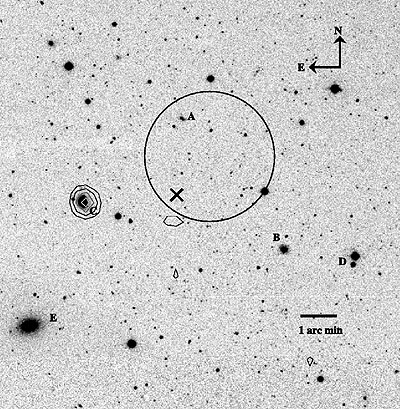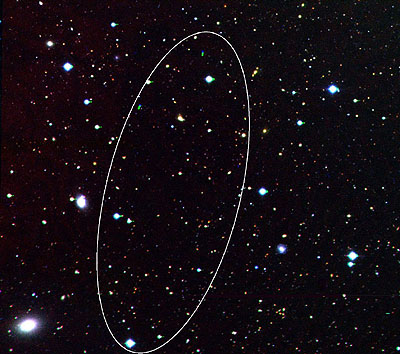 | |||
|
| Home > Public Information > Scientific Highlights > 2005 > A Dark Hydrogen Cloud in the Virgo Cluster |
|
A Dark Hydrogen Cloud in the Virgo Cluster
INT+WFC
Simulations of cold dark matter models predict far more dark matter halos than are observed as galaxies. For this reason, it has been hypothesized that there must exist dark matter halos that contain no stars.The advent of neutral hydrogen multibeam systems has allowed surveys of large areas of sky to be carried out with much higher sensitivity that has been possible in the past, thus allowing sources to be detected by their gas content alone rather than their stars and opening up the possibility of finding truly isolated clouds of extragalactic gas with no stars.
A recent deep neutral hydrogen survey of the Virgo Cluster (VIRGOHI) using the multibeam system on the Lovell Telescope has covered 32 deg2 and detected 31 sources, of which one of them, VIRGOHI 21, does not have an optical counterpart. There have been several previous claims of the detection of isolated clouds of extragalactic gas with no stars in them, but subsequent analyses have either revealed the optical counterparts or shown that the gas is mereley debris from nearby visible galaxies. Many other detections of HI clouds have been associated with nearby optically bright galaxies, but VIRGOHI 21 cannot be so easily explained. Following detection, VIRGOHI 21 was observed at Arecibo Telescope and the Very Large Array (VLA). From the HI flux astronomers calculated an HI mass of 108Msolar and a velocity width of ΔV20=220kms-1. From the speed it is spinning VIRGOHI 21 is a thousand times more massive that could be accounted for by the observed hydrogen atoms alone, and from the Tully-Fisher relation, a galaxy with this velocity width would be expected to be 12 mag or brighter.
Deep optical CCD images in B, r, and i bands with the INT were obtained, reaching surface brightness limits of 27.5, ~27.0 and 25.8 mag arcsec-2 respectively. On the B-band frame, an object of 10" scale or larger at this surface brightness limit should have been detected. This is more than 100 times dimmer than the central surface brightness of the disks of typical spiral galaxies and dimmer than any known massive low surface brightness galaxy or than the lowest surface brightness dwarf galaxy.
Astronomers have been measuring the way in which stars and galaxies move for many years. These measurements indicate that there must be far more matter in the Universe that can be accounted for by the visible light we see. This 'dark matter' still holds many mysteries for astronomers - is it well mixed up amongst the stars, or is it separate from the stars? Another puzzle is that the current ideas about how galaxies form predict that there should be many more galaxies in the Universe than are visible to us. So, these two ideas - dark matter and the lack of galaxies - have led to predict that there must be unseen 'dark' galaxies hidden in the Universe. Finding a dark matter galaxy is an important breakthrough because, according to cosmological models, dark matter is five times more abundant than the ordinary (baryonic) matter that makes up everything we can see and touch. The members of the discovery team conclude that in the very nature of things it would be difficult to make an indisputable claim to have found a dark galaxy, particularly when past claims to that effect have quickly been ruled out by subsequent observations (either of a dim underlying galaxy or of bridging connections to nearby visible companions). Nevertheless, VIRGOHI 21 passed all of the careful tests the astronomers were able to set for it, using the best equipment currently available.
Dark galaxies are thought to form when the density of matter in a galaxy is too low to create the conditions for star formation. The observations of VIRGOHI 21 may have other explanations, but they are consistent with the hydrogen being in a flat disc of rotating material, which is what is seen in ordinary spiral galaxies.
References:
|
| Top | Back |
|



